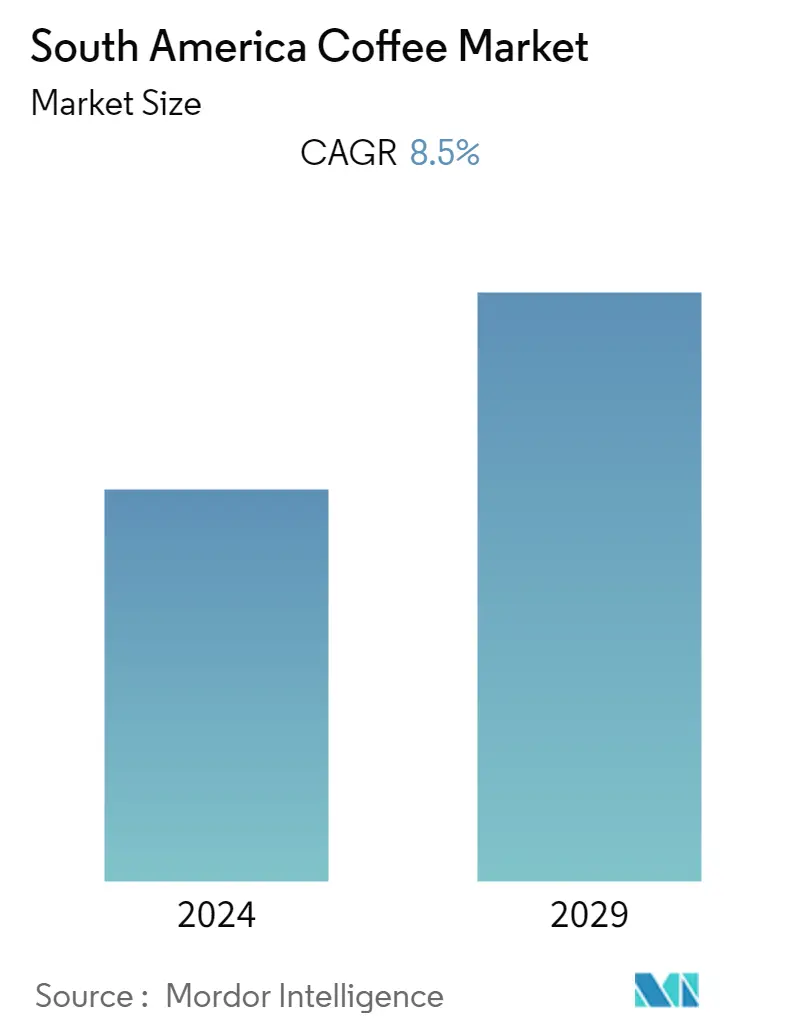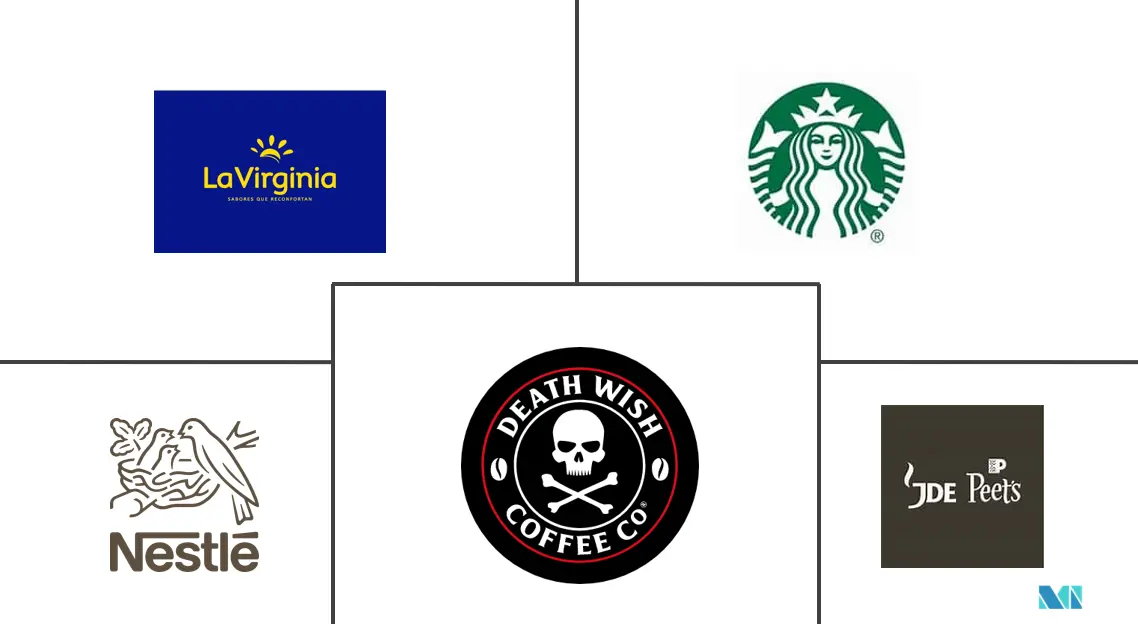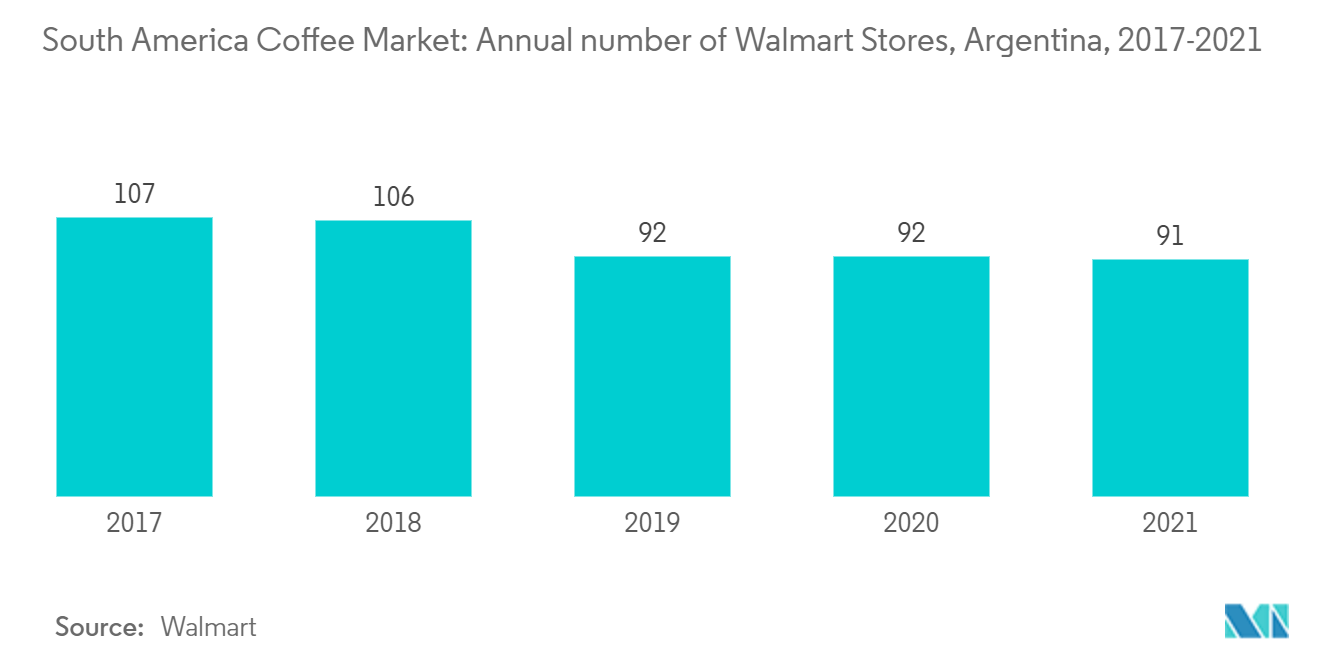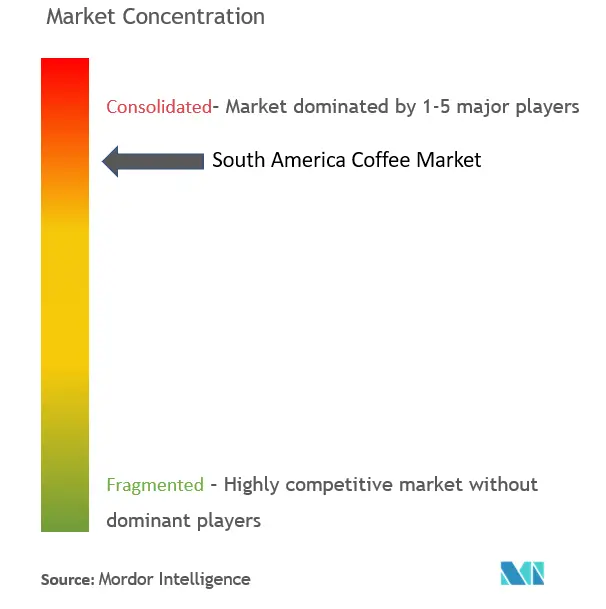South America Coffee Market Size

| Study Period | 2019 - 2029 |
| Base Year For Estimation | 2023 |
| Forecast Data Period | 2024 - 2029 |
| Historical Data Period | 2019 - 2022 |
| CAGR | 8.50 % |
| Market Concentration | High |
Major Players
*Disclaimer: Major Players sorted in no particular order |
South America Coffee Market Analysis
South America Coffee Market is projected to register a CAGR of 8.5% during the forecast period, 2022-2027.
More than 1.2 billion people rely on coffee for a living; the COVID pandemic was difficult for many in the coffee business; baristas were the first to close coffee shops, and several small coffee chains never reopened when the pandemic hit. The robust coffee supply network and coffee manufacturers ensured that consumers could acquire their coffee even during a pandemic. According to Brazilian Coffee Exports Council, Brazilian coffee exports hit 40.7 million bags in 2019, and annual domestic consumption is approximately 21 million bags. According to Brazil's association of e-commerce, ABComm, home purchases of coffee rose by 35% in Brazil in the early weeks of closures in Brazil in 2020. The market uncertainties have been causing large global coffee buyers to strengthen their stocks, buying additional bags of coffee to extend out additional months. Another point in Brazil's coffee chain that may be affected by the pandemic is from the farm to the export port. In Brazil, almost all coffee beans are transported in trucks from the countryside to the shores through highways. Many commercial establishments along these routes were closed, and the truck drivers are already having trouble finding support times such as restaurants, motels or other sleep stations. This delayed the flow of the beans in some regions of South America.
Over the medium term, the facility/outlet expansions of chains, like Starbucks, Havanna, Café Martinez, Bonafide, The Coffee Store, and multiple independent and premium specialist coffee stores, are attracting millennials. This is boosting the growth of the coffee market and increasing the consumption of the product.
Brazil boasts of the prevalence of out-of-home coffee consumption, where different types of coffee, like espressos, cappuccinos, and other milk-based preparations, are prominent. In addition, companies, such as Nestle, have launched several flavored instant coffee options and coffee pods, which recorded strong performance in terms of sales volumes.
South America Coffee Market Trends
This section covers the major market trends shaping the South America Coffee Market according to our research experts:
Increasing Spending Power Augmenting the Growth for Specialty Coffee
Increasing global exposure, western culture, and penetration of established coffee giants like Starbucks, Nestle, and JDE Peet's are anticipated to be the key factors that drive the expansion of coffee chains, especially in the South American region. Brazil is one of the top exporters of coffee. According to the World Bank in 2021, over the last five years, Brazil's economic stability and higher wages favored the ascension of more than 20 million people from the lower social classes to the middle classes. The per capita income increased from USD 6814.9 in 2020 to USD 7518.8 in 2021, and the new middle classes have already begun to influence consumption patterns.
Recently, coffee consumption witnessed tremendous growth as outlets gained popularity as hangout zones for friends, family, colleagues, and business associates, among others. Consumers in Argentina are inclined toward an improved quality of coffee and specialty coffee drinks as they continue to be exposed to a growing number of specialist coffee shops in the country. The Argentina coffee market is unique and lucrative, offering exciting business opportunities for new players and space for continued development and consolidation. According to a survey by USDA Foreign Agricultural Service in 2021, on average, coffee consumption in the country is recorded at a kilo of coffee per person per year, which is equivalent to one cup of coffee every two days.

Supermarket/Hypermarket Holds A Prominent Share
Owing to the large retail space and the availability of diversified product ranges across various brands like Starbucks, Nestle, and JDE Peet's, hypermarkets/supermarkets remained to be the most preferred point of sales for coffee. The wide product visibility at supermarkets/hypermarkets further boosts the consumer base, leading to escalated sales. The acts, such as business expansion and the rising number of hypermarkets and supermarkets, add to the sales of these retail formats and significantly contribute to the market. For instance, in March 2021, Carrefour SA bought Walmart Inc.'s former Brazil unit to cement its position as the country's largest supermarket operator.
The growing market share of the segment has increased the demand for purchasing products in bulk, as customers want to make fewer trips to the store and receive more value for their money, which, in turn, has also increased the sales of coffee across the world. In order to supplement their sales in this segment, key consumer brands, such as Nescafe, Bru, Folgers, and Jacobs, are progressively distributing their products through this channel. Some of the leading supermarket chains across South America are Walmart, Carrefour, Tesco, and Costco among others. Some of the major factors responsible for the growth of this segment are the growing retail industry, the establishment of numerous retail outlets, the availability of a wider range of products, discounted prices, and excellent shopping experiences.

South America Coffee Industry Overview
The South American Coffee Market facilitates its operation in a highly consolidated market with various global and regional players in the market. The major players in the South American coffee market include Starbucks Corporation, Death Wish Coffee Co., JDE Peet's, Cafes La Virginia S.A., and Nestle S.A.
Emphasis is given to the merger, expansion, acquisition, and partnership of the companies along with new product development as strategic approaches adopted by the leading companies to boost their brand presence among consumers. For instance, in 2020 Três Corações Group (a joint venture with Strauss Coffee) acquired Mitsui Alimentos' Roast and Ground Coffee business in Brazil, thereby strengthening its leadership position in the coffee market across the country.
South America Coffee Market Leaders
-
Death Wish Coffee Co.
-
JDE Peet's
-
Starbucks Corporation
-
Nestle SA
-
Cafes La Virginia S.A.
*Disclaimer: Major Players sorted in no particular order

South America Coffee Market News
- In May 2022, AriZona Beverages announced its foray into the coffee space with Sun Brew with its new line of 100% Arabica coffee made with hand-selected beans from Central and South America. Sun Brew is available in three roast styles, namely, Snake Bite Blend, Cactus Blend, and Sedona Blend. The coffees are sold online at DrinkAriZona.com, Amazon.com, and at select grocery stores across South America.
- In April 2022, Starbucks and Nestlé, through their global coffee alliance collaboration, launched an e-commerce site for Starbucks packaged coffee products. The site showcases items ranging from Starbucks by Nespresso espresso capsules to Starbucks roast and ground coffees, featuring a complete portfolio of Starbucks packaged coffee product options available to customers across Brazil for enjoyment in the comfort of their own homes.
- In December 2021, the coffee giant, Startbucks Corporation, planned to expand its café outlets in the world's top coffee-producing region of Brazil, Minas Gerais. The company opened eight new cafe stores in Brazil.
South America Coffee Market Report - Table of Contents
1. INTRODUCTION
- 1.1 Study Assumptions and Market Definition
- 1.2 Scope of the Study
2. RESEARCH METHODOLOGY
3. EXECUTIVE SUMMARY
4. MARKET DYNAMICS
- 4.1 Market Drivers
- 4.2 Market Restraints
-
4.3 Porter's Five Force Analysis
- 4.3.1 Threat of New Entrants
- 4.3.2 Bargaining Power of Buyers/Consumers
- 4.3.3 Bargaining Power of Suppliers
- 4.3.4 Threat of Substitute Products
- 4.3.5 Intensity of Competitive Rivalry
5. MARKET SEGMENTATION
-
5.1 By Product Type
- 5.1.1 Whole Bean
- 5.1.2 Ground Coffee
- 5.1.3 Instant Coffee
- 5.1.4 Coffee Pods and Capsules
-
5.2 By Distribution Channel
- 5.2.1 Supermarkets/Hypermarkets
- 5.2.2 Convenience Stores
- 5.2.3 Specialist Retailers
- 5.2.4 Online Retail Stores
- 5.2.5 Other Distribution Channels
-
5.3 By Country
- 5.3.1 Brazil
- 5.3.2 Argentina
- 5.3.3 Rest of South America
6. COMPETITIVE LANDSCAPE
- 6.1 Most Adopted Strategies
- 6.2 Market Share Analysis
-
6.3 Company Profiles
- 6.3.1 Molinos Rio de la Plata S.A.
- 6.3.2 Starbucks Coffee Company
- 6.3.3 Death Wish Coffee Co.
- 6.3.4 Volcanica Coffee Company
- 6.3.5 Nestle SA
- 6.3.6 Pilao Coffee
- 6.3.7 JDE Peet's
- 6.3.8 Café Caboclo
- 6.3.9 Cabrales S.A.
- 6.3.10 Cafes La Virginia S.A.
- *List Not Exhaustive
7. MARKET OPPORTUNITIES AND FUTURE TRENDS
8. IMPACT OF COVID-19 ON THE MARKET
9. DISCLAIMER
** Subject To AvailablitySouth America Coffee Industry Segmentation
Coffee is a beverage brewed from the roasted and ground seeds of the tropical evergreen coffee plants of African origin. Coffee contains caffeine, a stimulant that has been shown to increase energy levels and decrease fatigue by altering levels of certain neurotransmitters in the brain. South America coffee market is segmented by product type, distribution channel and by country. Based on product type, the market is segmented into whole bean, ground coffee, instant coffee, and coffee pods and capsules. Based on the distribution channel, the market is segmented into supermarkets/hypermarkets, convenience stores, specialist retailers, online retail, and other distribution channels, and by country the market is segmented into Brazil, Argentina, and the rest of South America. For each segment, the market sizing and forecasts have been done on the basis of value (in USD billion).
| By Product Type | Whole Bean |
| Ground Coffee | |
| Instant Coffee | |
| Coffee Pods and Capsules | |
| By Distribution Channel | Supermarkets/Hypermarkets |
| Convenience Stores | |
| Specialist Retailers | |
| Online Retail Stores | |
| Other Distribution Channels | |
| By Country | Brazil |
| Argentina | |
| Rest of South America |
South America Coffee Market Research FAQs
What is the current South America Coffee Market size?
The South America Coffee Market is projected to register a CAGR of 8.5% during the forecast period (2024-2029)
Who are the key players in South America Coffee Market?
Death Wish Coffee Co., JDE Peet's, Starbucks Corporation, Nestle SA and Cafes La Virginia S.A. are the major companies operating in the South America Coffee Market.
What years does this South America Coffee Market cover?
The report covers the South America Coffee Market historical market size for years: 2019, 2020, 2021, 2022 and 2023. The report also forecasts the South America Coffee Market size for years: 2024, 2025, 2026, 2027, 2028 and 2029.
South America Coffee Industry Report
Statistics for the 2024 South America Coffee market share, size and revenue growth rate, created by Mordor Intelligence™ Industry Reports. South America Coffee analysis includes a market forecast outlook to 2029 and historical overview. Get a sample of this industry analysis as a free report PDF download.



